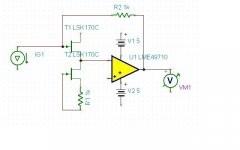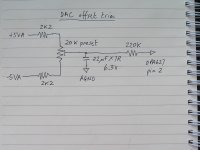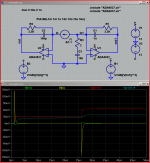While waiting for smms73 to get his discrete I/V kit up and going I would like some opinions on opamps for I/V use for the PCM1704.
It seems that most feel that the OPA627 is the favoured choice for I/V use, if one must use an opamp, the important specs for i/v seem to be the following.
OPA627
Bandwidth 16mhz
Settling time 550ns
Slew Rate 55v/us
The AD825 correct me if I'm wrong looks much better for I/V use on the data sheet
Bandwidth 41mhz
Settling time 80ns
Slew Rate 125v/us
Am I missing something, and is there even better opamps for this I/V use?
Cheers George
It seems that most feel that the OPA627 is the favoured choice for I/V use, if one must use an opamp, the important specs for i/v seem to be the following.
OPA627
Bandwidth 16mhz
Settling time 550ns
Slew Rate 55v/us
The AD825 correct me if I'm wrong looks much better for I/V use on the data sheet
Bandwidth 41mhz
Settling time 80ns
Slew Rate 125v/us
Am I missing something, and is there even better opamps for this I/V use?
Cheers George
PCM1704 - not recommended for new design - $75 ea?? and mono??
hard to argue against the OPA627 specs, but the price... well looking a the DAC price tag, maybe not an issue
AD825 Vnoise spec sucks - likely would degrade the DAC noise performance
slew rate is not so critical if you follow the PCM1704 datasheet circuit and use a feedback C for the 1st pole in the I/V
I'd lower fc enough to be one of the anti-image/reconstruction filter poles
but then the Cload may want a buffer in the loop
at least Class A bias the op amp output with a pull down
looks like the OPA637 could be used with a noise gain C to gnd at the input - has been suggested as a good idea for op amp I/V - shunts some of the fastest edges/glitches directly to gnd
much cheaper options exist, or faster - new linearized SiGe input bjt - but most options today are smt, the best even samller than soic-8
hard to argue against the OPA627 specs, but the price... well looking a the DAC price tag, maybe not an issue
AD825 Vnoise spec sucks - likely would degrade the DAC noise performance
slew rate is not so critical if you follow the PCM1704 datasheet circuit and use a feedback C for the 1st pole in the I/V
I'd lower fc enough to be one of the anti-image/reconstruction filter poles
but then the Cload may want a buffer in the loop
at least Class A bias the op amp output with a pull down
looks like the OPA637 could be used with a noise gain C to gnd at the input - has been suggested as a good idea for op amp I/V - shunts some of the fastest edges/glitches directly to gnd
much cheaper options exist, or faster - new linearized SiGe input bjt - but most options today are smt, the best even samller than soic-8
Last edited:
Hi George,
I've tried a few different op-amps with my PCM1792 design.
The main contenders in my opinion are the OPA627, LME49710, AD797, NE5534 and LT1028.
The result with each one is slightly different but not so evident. I'm not going to offer any strong opinion on the sound of each one as it's down to personal preference.
I've gone for the LME49710 metal can case. They are also very expensive (the metal can) but worth it.
The NE5534 sounds horrible compared with the others. The AD797 is sweet and the clarity is sublime. The OPA627 sounds very good but not worth the money (specially for a 1792 design which you need a bunch of).
Cheers,
I've tried a few different op-amps with my PCM1792 design.
The main contenders in my opinion are the OPA627, LME49710, AD797, NE5534 and LT1028.
The result with each one is slightly different but not so evident. I'm not going to offer any strong opinion on the sound of each one as it's down to personal preference.
I've gone for the LME49710 metal can case. They are also very expensive (the metal can) but worth it.
The NE5534 sounds horrible compared with the others. The AD797 is sweet and the clarity is sublime. The OPA627 sounds very good but not worth the money (specially for a 1792 design which you need a bunch of).
Cheers,
Last edited:
if GBW, loop gain, speed are good for I/V it looks like the AD8067 must be great
low noise bjt have large Inoise at the input, this causes V noise when multiplied by the I/V feedback R
with the low output I of the PCM1704 the I/V R is kOhm - most low noise bjt Inoise will cause more I/V output noise than the best fet input op amps Vnoise
OPA211, OPA1611 have low Inoise for this class of bjt op amps - the latter speced "for audio", recommended by Bruce Hofer
at the low Ipk-pk of the PCM1704 I would more likely go with fet input op amp I/V
FET inputs are also expected to be more immune to RFI or DAC switching noise/glitch
op amp Vnoise ~ <6 nV/sqrt(Hz) about equals the noise of the 2.5 kOhm I/V R in the datasheet circuit
fet input meeting the noise requirements like opa627/637 and the more recent parts clearly aimed at replacing them would be my 1st try for something simple
AD8610 AD4627/4637 OPA827
at lower cost but still with good audio specs the OPA164x parts look fine too
for something "sporty", a design challenge (and an excuse to get a faster 'scope) you could see if you can noise gain stabilize a AD8067 - >1/2 GHz GBW, 640 V/us - at a slight audio noise penalty
low noise bjt have large Inoise at the input, this causes V noise when multiplied by the I/V feedback R
with the low output I of the PCM1704 the I/V R is kOhm - most low noise bjt Inoise will cause more I/V output noise than the best fet input op amps Vnoise
OPA211, OPA1611 have low Inoise for this class of bjt op amps - the latter speced "for audio", recommended by Bruce Hofer
at the low Ipk-pk of the PCM1704 I would more likely go with fet input op amp I/V
FET inputs are also expected to be more immune to RFI or DAC switching noise/glitch
op amp Vnoise ~ <6 nV/sqrt(Hz) about equals the noise of the 2.5 kOhm I/V R in the datasheet circuit
fet input meeting the noise requirements like opa627/637 and the more recent parts clearly aimed at replacing them would be my 1st try for something simple
AD8610 AD4627/4637 OPA827
at lower cost but still with good audio specs the OPA164x parts look fine too
for something "sporty", a design challenge (and an excuse to get a faster 'scope) you could see if you can noise gain stabilize a AD8067 - >1/2 GHz GBW, 640 V/us - at a slight audio noise penalty
Last edited:
If you are into SMD and can design a really good board, then look into the LME49990. If you want a low impedance feedback loop, than include an LME49600 with the opamp.
Yeah i had my eye on the LME49990 for a while just never got around testing it.
Do you have any example schematics with what you describe, i've never tried this approach.
This guy/guys seem to think highly of the LT1028 I don't know what their creds are like?
http://www.by-rutgers.nl/IV-converter.html
Cheers George
http://www.by-rutgers.nl/IV-converter.html
Cheers George
Hi George,
I've tried several opamps as I/V converters (subjective evaluation) and my favourite is TI's OPA827, OPA627 cheaper (and better sounding, IMHO) successor.
OPA827's applications include transimpedance amp,
Also LME49710/720 is a very good sounding opamp as I/V, just a bit less musical than OPA827.
Also OPA211 is a good one but inferior to 827 and 49720.
OPA211 is superior, IMHO, to its SoundPlus counterpart OPA1611
Compared opamps: OPA2132, OPA2134, OPA211, OPA1612, OPA1643, OPA827, OPA627, OPA2107, THS4032, LME49720, NE5532, LT1028, OP275, others I can't remember now.
I've tried several opamps as I/V converters (subjective evaluation) and my favourite is TI's OPA827, OPA627 cheaper (and better sounding, IMHO) successor.
OPA827's applications include transimpedance amp,
Also LME49710/720 is a very good sounding opamp as I/V, just a bit less musical than OPA827.
Also OPA211 is a good one but inferior to 827 and 49720.
OPA211 is superior, IMHO, to its SoundPlus counterpart OPA1611
Compared opamps: OPA2132, OPA2134, OPA211, OPA1612, OPA1643, OPA827, OPA627, OPA2107, THS4032, LME49720, NE5532, LT1028, OP275, others I can't remember now.
ADA4627/4637 must be the competitor of OPA627/637.
it seems a successor of AD8610/8620.
ADA4898-1/ADA4898-2 seems competitor of OPA211 and LM49990 and so on, modern opamps.
you should not think little of offset spec of opamps.
the output impedance of binary weighted DAC varies along with input binary, especially at higher order bits.
if the output Z varies, then the noise gain varies. and the offset voltage will be modulated and become distortion.
It is more important ordinary R2R DAC, but it may be less at PCM1704 because it is sign magnitude DAC.
(sign magnitude DAC do not switch highly weighted element at bipoler zero)
it seems a successor of AD8610/8620.
ADA4898-1/ADA4898-2 seems competitor of OPA211 and LM49990 and so on, modern opamps.
you should not think little of offset spec of opamps.
the output impedance of binary weighted DAC varies along with input binary, especially at higher order bits.
if the output Z varies, then the noise gain varies. and the offset voltage will be modulated and become distortion.
It is more important ordinary R2R DAC, but it may be less at PCM1704 because it is sign magnitude DAC.
(sign magnitude DAC do not switch highly weighted element at bipoler zero)
low noise bjt have large Inoise at the input, this causes V noise when multiplied by the I/V feedback R
with the low output I of the PCM1704 the I/V R is kOhm - most low noise bjt Inoise will cause more I/V output noise than the best fet input op amps Vnoise
Ah, very interesting! Thanks for sharing. I was actually able to follow what you said and I agree. For low output current DACs, an fet input opamp would produce lower noise than a bjt input opamp.
Well, there is the option of adding a discrete fet follower inside the feedback loop of the bjt opamp. It's something to play with anyway, and has been done before.
Attachments
looks like the OPA637 could be used with a noise gain C to gnd at the input - has been suggested as a good idea for op amp I/V - shunts some of the fastest edges/glitches directly to gnd
much cheaper options exist, or faster - new linearized SiGe input bjt - but most options today are smt, the best even samller than soic-8
Jcx, Can you please explain what you mean by " a noise gain C to gnd at the input"
and if possible the opamps that you suggest in smt , Thanks
smms
these documents are informative.
http://www.analog.com/static/imported-files/application_notes/AN-257.pdf
http://www.ti.com/lit/an/slyt174/slyt174.pdf
these documents are informative.
http://www.analog.com/static/imported-files/application_notes/AN-257.pdf
http://www.ti.com/lit/an/slyt174/slyt174.pdf
Hi JCX, I have done a mod which has me falling in love again with the OPA627 as the I/V.
My cdp has as you know a PCM1702K for each channel, I was always bothered that they gave dc offset to the OPA627 I/V. With the help of abraxalito, I got rid of it (circuit attached)
This is the post I sent to him and I would like your opinion as well.
"thank you very much for the dc offset nulling circuit it worked a treat, instead of 17mV left and 50mV right comming out of the OPA627 I/V's now I have +- .1mV I don't know why but the sound has improved very much overhaul esspecially in the bass. Is this possible, that the OPA627 as an I/V does not like to see any dc comming into it from the dac/s???"
Cheers George
My cdp has as you know a PCM1702K for each channel, I was always bothered that they gave dc offset to the OPA627 I/V. With the help of abraxalito, I got rid of it (circuit attached)
This is the post I sent to him and I would like your opinion as well.
"thank you very much for the dc offset nulling circuit it worked a treat, instead of 17mV left and 50mV right comming out of the OPA627 I/V's now I have +- .1mV I don't know why but the sound has improved very much overhaul esspecially in the bass. Is this possible, that the OPA627 as an I/V does not like to see any dc comming into it from the dac/s???"
Cheers George
Attachments
shinja's refs are good for noise gain compensation - allowing the use of decomp op amps at unity gain - like op amp I/V
the question with sims is the model accuracy - output Cload effects in particular - so beware - the sim below doesn't seem too sensitive adding ~50 Ohm in the op amp outputs so may not be too bad - but as speed goes up, op amp macromodels are worse
Analog Devices in particular is frustrating in printing one of the better macromodeling app notes ever - and not using it for their own Spice models - even posting too simple models with impossibly ideal sources for its most recent, highest performance op amps where output Z, even bond wire L is critical to real performance - or outright failure to even grossly indicate stability
below is a simmed comparison of the PCM1704 datasheet I/V on the left and the noise gain compensated ADA4637 with higher feedback C
I plotted the V at the I/V op amp inputs - Hawksford makes the point that a quality criteria for I/V quality can be the magnitude, and extent in time of this error
so I also plotted the integral of the input Verror squared - note the blue trace for the noise gain circuit on the right has 100x extra gain to be seen on the same scale
(to run the sim you need to download Analog's op amp Spice .cir models to the same directory as the .asc)
the question with sims is the model accuracy - output Cload effects in particular - so beware - the sim below doesn't seem too sensitive adding ~50 Ohm in the op amp outputs so may not be too bad - but as speed goes up, op amp macromodels are worse
Analog Devices in particular is frustrating in printing one of the better macromodeling app notes ever - and not using it for their own Spice models - even posting too simple models with impossibly ideal sources for its most recent, highest performance op amps where output Z, even bond wire L is critical to real performance - or outright failure to even grossly indicate stability
below is a simmed comparison of the PCM1704 datasheet I/V on the left and the noise gain compensated ADA4637 with higher feedback C
I plotted the V at the I/V op amp inputs - Hawksford makes the point that a quality criteria for I/V quality can be the magnitude, and extent in time of this error
so I also plotted the integral of the input Verror squared - note the blue trace for the noise gain circuit on the right has 100x extra gain to be seen on the same scale
(to run the sim you need to download Analog's op amp Spice .cir models to the same directory as the .asc)
Attachments
Last edited:
as an example of ADI Spice modeling "excellence" (not) - I just stuck the AD8067 model in the above sim - even better dynamic error
but the sim's integrated error plot is spoiled by the AD8027 Spice model ~74 dB open loop gain - where the datasheet clearly claims 100 dB min, ~120 dB typical
but the sim's integrated error plot is spoiled by the AD8027 Spice model ~74 dB open loop gain - where the datasheet clearly claims 100 dB min, ~120 dB typical
If it has to be opamp then this is the one I shall build, using OPA1641 :
http://www.diyaudio.com/forums/digi...ertion-very-low-distortion-6.html#post3133418
http://www.diyaudio.com/forums/digi...ertion-very-low-distortion-6.html#post3133473
Patrick
http://www.diyaudio.com/forums/digi...ertion-very-low-distortion-6.html#post3133418
http://www.diyaudio.com/forums/digi...ertion-very-low-distortion-6.html#post3133473
Patrick
- Status
- This old topic is closed. If you want to reopen this topic, contact a moderator using the "Report Post" button.
- Home
- Source & Line
- Digital Source
- I/V using opamps


